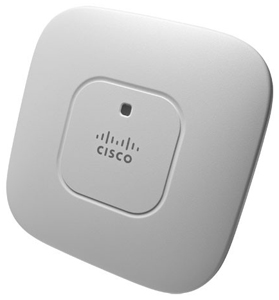
Cisco Aironet 700 Series Access Point
Compact, Reliable 802.11n-Based Performance

מחירים נוספים מופיעים למטה, או לחצו כאן!
שימו לב: כל המחירים באתר כוללים מע"מ. החיוב יבוצע על פי שער "העברות והמחאות מכירה" של המטבע (דולר אמריקאי) ביום אישור ההזמנה.
Overview:
The Cisco Aironet 700 Series offers a compact access point for value-minded customers looking to modernize their networks to handle today's increasingly complex wireless access demands.
With 802.11n dual-radio 2 x 2 multiple-input multiple-output (MIMO) technology providing at least six times the throughput of existing 802.11a/g networks, the Cisco Aironet 700 Series offers the performance advantage of 802.11n quality at a competitive price.
As part of the Cisco Unified Wireless Network, the 700 Series Access Point provides low total cost of ownership and investment protection by integrating seamlessly with the existing network.
RF Excellence
Building on the Cisco Aironet heritage of RF excellence, the 700 Series Access Point delivers secure and reliable wireless connections with:
- Simultaneous dual band, dual radio with support for 2.4GHz and 5GHz
- Optimized antenna and radio designs: Consistent network transmit and receive for optimized rate versus range
- Radio resource management (RRM): Automated self-healing optimizes the unpredictability of RF to reduce dead spots and help ensure high-availability client connections
- Cisco BandSelect improves 5-GHz client connections in mixed-client environments
- Advanced security features including Rogue Detection, wIPS and Context-Aware
Scalability
The Cisco Aironet 700 Series is a component of the Cisco Unified Wireless Network, which can provide full Layer 3 mobility across central or remote locations on the enterprise campus, in branch offices, and at remote sites. The Cisco Unified Wireless Network is the industry's most flexible, resilient, and scalable architecture delivering secure access to mobility services and applications, and offering the lowest total cost of ownership and investment protection by integrating seamlessly with the existing wired network.
Features and Capabilities
Features of the Cisco Aironet 700 Series Access Point include:
- Simultaneous dual-band dual-radio 2.4 GHz and 5 GHz support with integrated internal antennas
- Up to six times more capacity to support applications and clients than legacy 802.11a/b/g networks
- Competitively priced controller-based and autonomous access-point
- Ideal for Cisco's Connected Mobile Experience Solution
- Limited Lifetime Hardware Warranty, including 10-day advance hardware replacement
Features:
Performance with Investment Protection
- Six times faster than 802.11a/g networks
- Dual-radio, simultaneous 2.4GHz and 5GHz support
- Backward-compatible with 802.11a/b/g clients
Easy Installation and Power Efficient
- 802.11n performance with existing Power-over-Ethernet (PoE) switches
- Sleek design blends into a variety of indoor environments
- UL 2043 plenum-rated for above-ceiling installation options or suspended from drop ceilings
Secure Interoperability
- 802.11n compliant
Simplified Network Management
- Controller-based deployment options
- Stand-alone options
Secure Connections
- Supports rogue access point detection and denial of service attacks
Greater Network Capacity
- Dynamic frequency selection 2 (DFS-2) compliant
Easy-to-Install, Multipurpose Mounting Bracket
- Small, compact form factor designed for a variety of mounting options for easy installations for indoor deployments
- Lock options for theft protection
Technical Specifications:
| Item | Specification |
|---|---|
| Software |
|
| Deployment Modes | Controller-based, FlexConnect, Monitor, Converged Access and Autonomous |
| 802.11n |
|
| Integrated Antenna |
|
| Interfaces |
|
| Indicators | Status LED indicates boot loader status, association status, operating status, boot loader warnings, boot loader errors |
| Dimensions (W x L x H) |
Access point (without mounting bracket): 7 x 7 x 2 inches (177.6 x 177.6 x 50.4 mm) |
| Weight | 1.06 lb (0.48 kg) |
| Environmental | Cisco Aironet 700
|
| System Memory |
|
| Input Power Requirements |
|
| Power draw | 9.5W (maximum) Note: When deployed using PoE, the power drawn from the power sourcing equipment will be higher by some amount dependent on the length of the interconnecting cable. This additional power may be as high as 1.3W, bringing the total system power draw (access point + cabling) to 10.8W. |
| Powering options |
|
| Warranty | Limited Lifetime Hardware Warranty |
| Compliance Standards |
Safety:
Radio approvals:
IEEE Standard:
Security:
Extensible Authentication Protocol (EAP) types:
Multimedia:
Other:
|
RF Performance:
| Data rates supported | ||||||
|---|---|---|---|---|---|---|
| 802.11a: 6, 9, 12, 18, 24, 36, 48, and 54 Mbps | ||||||
| 802.11bg: 1, 2, 5.5, 6, 9, 11, 12, 18, 24, 36, 48, 54 Mbps | ||||||
| 802.11n data rates on 2.4 GHz: | ||||||
| MCS Index1 | GI2 = 800 ns | GI = 400 ns | ||||
| 20-MHz Rate (Mbps) | 40-MHz Rate (Mbps) | 20-MHz Rate (Mbps) | 40-MHz Rate (Mbps) | |||
| 0 | 6.5 | 13.5 | 7.2 | 15 | ||
| 1 | 13 | 27 | 14.4 | 30 | ||
| 2 | 19.5 | 40.5 | 21.7 | 45 | ||
| 3 | 26 | 54 | 28.9 | 60 | ||
| 4 | 39 | 81 | 43.3 | 90 | ||
| 5 | 52 | 108 | 57.8 | 120 | ||
| 6 | 58.5 | 121.5 | 65 | 135 | ||
| 7 | 65 | 135 | 72.2 | 150 | ||
| 8 | 13 | 27 | 14.4 | 30 | ||
| 9 | 26 | 54 | 28.9 | 60 | ||
| 10 | 39 | 81 | 43.3 | 90 | ||
| 11 | 52 | 108 | 57.8 | 120 | ||
| 12 | 78 | 162 | 86.7 | 180 | ||
| 13 | 104 | 216 | 115.6 | 240 | ||
| 14 | 117 | 243 | 130 | 270 | ||
| 15 | 130 | 270 | 144.4 | 300 | ||
| Frequency band and 20-MHz operating channels | ||||||
A (A regulatory domain):
C (C regulatory domain):
D (D regulatory domain):
E (E regulatory domain):
H (H regulatory domain):
I (I regulatory domain):
K (K regulatory domain):
|
N (N regulatory domain):
Q (Q regulatory domain):
R (R regulatory domain):
S (S regulatory domain):
T (T regulatory domain):
Z (Z regulatory domain):
|
|||||
| Note: This varies by regulatory domain. Refer to the product documentation for specific details for each regulatory domain. | ||||||
| Maximum number of nonoverlapping channels | ||||||
2.4 GHz
|
5 GHz
|
|||||
| Note: This varies by regulatory domain. Refer to the product documentation for specific details for each regulatory domain. | ||||||
| Receive sensitivity | ||||||
802.11b
|
802.11g
|
802.11a
|
||||
| 2.4-GHz 802.11n (HT20)
|
5-GHz 802.11n (HT20)
|
5-GHz 802.11n (HT40)
|
||||
| Maximum transmit power | ||||||
2.4 GHz
|
5 GHz
|
|||||
| Note: The maximum power setting will vary by channel and according to individual country regulations. Refer to the product documentation for specific details. | ||||||
2.4 GHz
|
5 GHz
|
|||||
| Note: The maximum power setting will vary by channel and according to individual country regulations. Refer to the product documentation for specific details. | ||||||
1MCS Index: The Modulation and Coding Scheme (MCS) index determines the number of spatial streams, the modulation, the coding rate, and data rate values.
2GI: A guard interval (GI) between symbols helps receivers overcome the effects of multipath delays.
3MCS Index: The Modulation and Coding Scheme (MCS) index determines the number of spatial streams, the modulation, the coding rate, and data rate values.
4GI: A guard interval (GI) between symbols helps receivers overcome the effects of multipath delays.
5MCS Index: The Modulation and Coding Scheme (MCS) index determines the number of spatial streams, the modulation, the coding rate, and data rate values.
Documentation:
Download the Cisco Aironet 700 Series Access Point Datasheet (PDF).
הערות תמחור:
- מחירי המוצרים וזמינותם כפופים לשינויים ללא הודעה מוקדמת.
